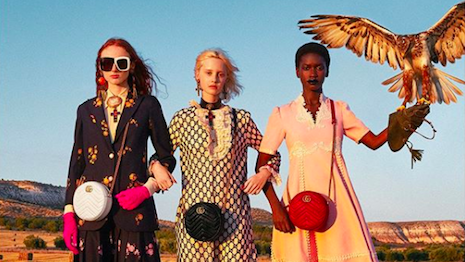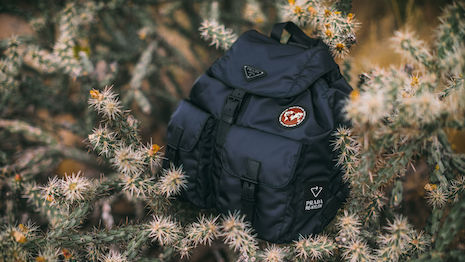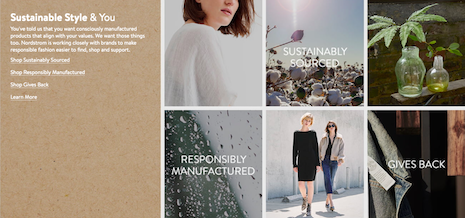 Gucci parent Kering led the pact creation. Image credit: Gucci
Gucci parent Kering led the pact creation. Image credit: Gucci
A coalition of 32 fashion companies are joining forces to tackle environmental issues such as climate change, biodiversity restoration and ocean protection, seeking to scale up their individual efforts with common objectives.
Led by luxury group Kering, under the mandate of France’s President Emmanuel Macron, the Fashion Pact launched during the G7 meeting over the weekend. While each of the pact participants has their own environmental initiatives, the project aims to leverage strength in numbers to enact change through the private sector.
"The Fashion Pact is founded on a 'result-focused' management – companies can choose the means but at the end of the day, what matters is that they all reach the common targets," said Marie-Claire Daveu, chief sustainability officer at Kering.
"For the first time in the fashion industry, the Fashion Pact unites CEOs of 32 global leading companies from the fashion and textile industry – fashion, sports, lifestyle and luxury as well as suppliers and retailers – committing to a common core of ambitious quantified environmental objectives focusing on three themes: climate, biodiversity and oceans."
Fashion forward
In April, President Macron directed Kering chairman/CEO François-Henri Pinault to spearhead the project, with the mission of bringing together players in the fashion and textile industries to reduce the environmental impact of their operations.
The pact was presented to heads of state during the G7 meeting in Biarritz, France from Aug. 24 to 26.
While the pact was initiated by France, the member companies hail from around the globe.
Along with Kering, the pact participants include Burberry, Capri Holdings, Chanel, Ermenegildo Zegna, Galeries Lafayette, Giorgio Armani, Hermès, Karl Lagerfeld, Matchesfashion.com, Moncler, Nordstrom, Prada, Ralph Lauren, Salvatore Ferragamo, Selfridges, Stella McCartney and Tapestry, among others.
Even though it has surpassed its goal of getting 20 percent of the industry involved based on volume, the pact remains open to other companies.
"Four months after receiving this mandate, the result is highly successful," Ms. Daveu said. "This coalition is unprecedented. These 32 signatories to date represent 150 brands in the world.
"With this Fashion Pact, we have over 30 percent of the fashion industry’s output by volume. And this is only the beginning; the coalition is open."
Due to its size and the nature of its business, the fashion industry has a great impact on the environment. Because of this, the pact sees fashion and textiles as potential key players in combating ecological damage.
One main area of focus for pact members will be their raw material sourcing, a factor that companies often overlook in terms of environmental impact.
The pact members will work towards bringing their greenhouse gas emissions to net zero by 2050, through both reduction and offsets. This is an effort to keep climate change between now and 2100 below a 1.5 degrees Celsius pathway.
Pact participants are also pledging to switch to entirely renewable energy by 2030, including across their supply chains and manufacturing.
Burberry's operations in a number of regions are already carbon neutral. Image courtesy of Burberry
Another way that the pact is tackling the issue of climate change is through sustainable sourcing of raw materials, taking into account the impact of activities such as farming.
Pact members will also support the UNFCCC Fashion Industry Charter, with plans to adopt science-based targets (SBCs).
Another area that the pact covers is biodiversity, which it says has not been significantly tackled by the fashion industry. Each of the companies will work to develop its own goals for species and ecosystem loss prevention revolving around SBCs.
As examples, goals could include initiatives that prevent deforestation or farming practices that restore soil and grasslands. Companies may also target animal welfare and conservation.
Also at risk are the oceans, which have seen biodiversity decline. For instance, coral reefs are in danger of dying out due to factors such as pollution and overfishing.
In an effort to protect the oceans, the pact includes the elimination of single-use plastic by 2030.
Pact members will also take on pollution in their supply chains and production, and will work to innovate to prevent microfibers from being released into water via synthetic fabrics.
In addition to internal goals, the pact intends to encourage cross-sector innovation and collaboration.
"Sustainability is a global movement despite the sector and it's quite logical that the fashion companies that represent the most polluted industry are willing to be part of the positive change, either because of the business goals or because of the willingness to serve the society," said Yana Bushmeleva, chief operating officer at Fashionbi, Milan.
"I believe that this pact is the first really important step within the fashion industry since it combines companies and even competitive brands which are united with a single goal, to be committed to sustainability targets," she said. "Before, we have witnessed some isolated activities by some companies without any clear KPIs and monitoring, and not all of the brands that have launched a sustainable campaign have shared with the public the impact of their activities.
"In this pact, we see that 'There should be quantitative targets based on science that can be achieved by both individual companies as well as the industry as a whole.' And it gives hope that from theory we finally moved into the practice.
"The fashion industry is really a global movement that consists not only from retailers but from manufacturers and customers. One in six people on the planet work in the fashion industry, so the fashion industry has a huge power to destroy or save the world where we live."
Prada Re-Nylon bags are made with upcycled nylon. Image credit: Prada
Beyond their own supply chains, the companies involved are also focusing on options to extend products' lifecycles and increase circularity.
"As one of the world's largest industries viewed by all levels and ages of consumer, the fashion industry has the ability to empower us all to impact change," said Robert Lockyer CEO of Delta Global. "We are already seeing so many fashion brands doing more to offer a circular life for their items, brands like Farfetch have introduced a reselling Web site and many other second life sites have been set up such as Village Luxe, The RealReal and Vestiaire Collective.
"People are coming together to encourage a green-thinking society that although fast-paced, is beginning to respect the environment and give a new life to style," he said.
"So many other businesses are affected by the fashion industry, along with many other consumer goods and services, which are influenced by fashion trends. Let’s harness this effect for change for good at all levels of sustainability."
Taking a leadership role, the pact members will also work to educate up-and-coming designers about sustainability.
As part of its participation in the pact, Nordstrom has created a new category on its ecommerce site devoted to Sustainable Style. The retailer says it is the first U.S. multi-brand seller to categorize products in this fashion, pointing to fashion that was sourced sustainably, made in eco-friendly conditions or gives back.
Nordstrom's Sustainable Style category. Image credit: Nordstrom
"[The Fashion Pact] will undoubtedly elevate [participating brands'] creditability with their existing and future customer base," Mr. Lockyer said. "Globally, sustainability is the single biggest issue fashion and other industries face right now, customers are instantly connected 24 hours a day in this digital age and want to know what fashion is doing to change the issue our oceans and planet face.
"We're beginning to see the retention of customers based on the shared values they hold with the brands they buy from."
Working together
Other initiatives have aimed to create standardization in environmental protection.
For instance, British label Stella McCartney is working with technology giant Google to help the fashion industry become more sustainable.
Through a pilot program, Google will be building a data analytics tool to assist brands in gaining an understanding of the environmental impact of their supply chains. As brands strive to be more eco-friendly in their production, the raw material stage is often difficult to measure, something that Stella McCartney and Google are looking to change (see story).
While luxury labels are among the fashion industry’s frontrunners in sustainability, these companies are facing challenges to achieve additional progress and impact.
A 2018 report from the Boston Consulting Group and the Global Fashion Agenda found that luxury brands improved their sustainability performance over 2017. Despite improvements in the overall fashion industry’s sustainability, the report noted that there is still room for improvement.
Along with other frontrunners, luxury players are seeing less return on their sustainability efforts. The report suggests that brands collaborate with others in the industry to drive further sustainability (see story).
"Businesses can make a difference, but they need to collaborate and to work altogether towards the same goals," Ms. Daveu said. "We will have a bigger impact this way rather than each one running in its own track.
"The global fashion industry is one of the largest, most dynamic and influential industries on the planet, generating over 1.5 trillion euros a year in revenues," she said. "The fashion industry is responsible for producing 20 percent of global wastewater and 10 percent of global carbon emissions. However, it also has the power to play a pivotal role in leading the shift towards a more sustainable future.
"Since fashion uses a lot of natural resources and sets the trends, it has a specific responsibility in contributing to protect the planet and stop 'business-as-usual.' We know now that most of the environmental impacts are located in the 'first miles' of the supply chain, i.e. raw material processing and production. It means that we need to continue to implement and scale up sustainable sourcing programs for raw materials, for example, and we also need to accelerate."



